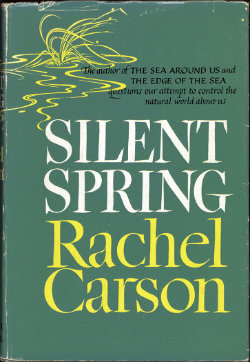Silent Spring: Chemical, Biological and Technological Visions of the post-1945 Environment
Postgraduate workshop
Humanities Research Centre, University of York, BS/008, Friday 1st March 2013
‘In this now universal contamination of the environment, chemicals are the sinister and little-recognised partners of radiation in changing the very nature of the world – the very nature of its life.’ – Rachel Carson, Silent Spring, 1962.
Rachel Carson’s classic polemic Silent Spring celebrated its 50th anniversary in 2012: it still stands as one of the most influential texts on the damage caused to the natural environment by chemicals and nuclear fallout in the twentieth century. Taking Carson’s book as its starting point, this interdisciplinary post-graduate workshop aims to explore how a growing awareness of the biological, chemical and technological changes to the environment has shaped cultural explorations of nature and landscape in the post-1945 period, through visual art, literature and film. It will consider both how scientists have used images and texts to communicate their ideas to the public, and how artists have responded to, used, and resisted scientific developments in their work. Through the workshop, we will start unpacking some of the complications inherent in the use of terms such as ‘nature’ and ‘environment’, and the associations embedded in them.
The workshop will provide an informal but stimulating forum for researchers and scholars from across the humanities, social sciences and natural sciences to share their work and ideas, and we invite contributions of 10-15 minutes based around texts, images, objects or artworks to act as focal points for wider questions and group discussion. Themes for presentations could include, but are by no means limited to:
The impact of environmentalism and its intersection with the heritage of Romantic traditions and Transcendentalism; manifestations of resistance and protest against environmental degradation
- The ways in which waste and rubbish, including landfill sites and pollution, have changed understandings of the ‘natural’
- Links between biological and chemical developments and military technologies (played out in the Cold War and the Vietnam war, for example)
- The use of gendered binaries in the representation of science and nature, such as the role of new technologies for representing pregnancy
- The mass-media’s part in relaying visions of the changing environment, particularly regarding the challenge to convey the scientifically un-representable or ‘unseen’ environmental threat
- Celebrations of the technological sublime or recuperation of the apparently industrially degraded or overlooked.
If you are interested in presenting, please send abstracts of up to 250 words to Catherine at ces528@york.ac.uk by Friday 4th January 2013. Equally, if you would like to participate but not present, then please do still get in touch to register your interest, as spaces are limited. The workshop is organised by Sophie Jones (Department of English, Birkbeck), Stephanie Lambert (English and Related Literatures, University of York), Catherine Spencer (History of Art, University of York) and Isabella Streffen (Fine Art, Newcastle University).

